Click image below for a larger view and a handy printable version.
A HALACHIC GUIDE TO HONEY AND BEE DERIVATIVES
Click here for STAR-K’s Halachic Guide to Honey and Bee Derivates by Rabbi Dovid Heber.

Click image below for a larger view and a handy printable version.
A HALACHIC GUIDE TO HONEY AND BEE DERIVATIVES
Click here for STAR-K’s Halachic Guide to Honey and Bee Derivates by Rabbi Dovid Heber.

Published Fall 2010
Introduction
On Rosh HaShana, everything we do is imbued with extreme significance. We stand in judgment before the Heavenly Court while each of our actions, words, and thoughts are scrutinized. To assist our efforts in currying Divine mercy, we employ various customs transmitted by our ancient mesorah. Among them is the regimen of the simanim, literally signs or omens. These are the foods that we bring to the table at the beginning of the evening meal as auspicious indications of a propitious year to come. What are the origins of this unusual custom? How can we be meticulous in its performance? How do we harness its power to usher in a year of prosperity?

Fall 2010
As we look toward the beginning of the new year, we turn our thoughts to teshuva, and the hope that our tefillos will be answered for a sweet new year. This request has been symbolized for hundreds of years on Rosh Hashana by eating challah and apples dipped in honey.1
The question regarding the kosher status of honey is older than the custom of dipping an apple on Rosh Hashana. There is a well known halacha that states that derivatives of non-kosher species are not kosher;2 this would include camel’s milk and ostrich eggs. Since a bee is a non-kosher insect, how can honey which comes from a bee be permissible to eat? Furthermore, if honey is kosher, are all products manufactured by the bee, e.g. royal jelly, beeswax, bee venom, and propolis (described below) also kosher?
The Kashrus of Honey
A brief entomological review of this remarkable insect is necessary in […]